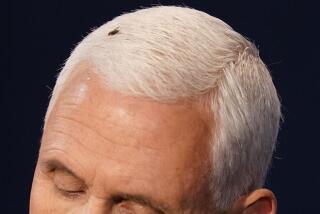Candid camera
- Share via
IN ITS QUEST TO spice up this month’s presidential debates in New Hampshire, CNN repeatedly let members of the audience take the microphone and ask questions. Now it’s planning to let them take the camera too. In a pair of debates to be held in July and September, the questions will be posed not by a panel of journalists but by YouTube users who record their queries as video clips. It’s a gimmick, but one that could yield some potent results.
Debates held this early in the campaign season suffer from at least three fundamental weaknesses. They don’t draw much of an audience (this year’s initial debates have each attracted less than 3 million viewers). The questions tend to reflect what journalists are interested in. And the format encourages candidates to jab and weave rather than engage in real debate.
The YouTube input could help on all these fronts. Although much of what’s posted on the site is silly or narcissistic, there’s a serious streak too, as users take sides on issues and hold politicians accountable. For example, the site played a critical role in derailing the political career of former Sen. George Allen (R-Va.) by hosting a clip of Allen calling an opponent’s campaign worker a “macaca.”
Depending on how CNN filters them, the YouTube questions also could provide a reasonably good proxy for what matters most to the grass roots. And if given free rein, YouTubers would be uniquely positioned to put the screws to presidential aspirants because they can paste in clips of the candidates doing or saying things they’d just as soon forget. If any of them have their own macaca moment, they and their rivals could take turns dissecting the replay on live TV.
It may be quixotic to hope for much in the first go-around. Although YouTubers clearly know how to use their medium to score political points -- witness how a supporter of Barack Obama turned Apple’s famous “1984” commercial into an attack on Hillary Rodham Clinton -- they’ve never taken part in an honest-to-goodness presidential debate. Still, CNN and YouTube are offering the public a tool it’s never had before: the ability to confront politicians directly with images, not just text. Imagine what a politically astute, video savvy person might do with topics such as the war in Iraq, New Orleans in the wake of Hurricane Katrina, the sub-prime loan fiasco or children without health insurance. No matter what they said, the candidates would have a hard time matching the power of heart-wrenching video with words alone.
More to Read
The biggest entertainment stories
Get our big stories about Hollywood, film, television, music, arts, culture and more right in your inbox as soon as they publish.
You may occasionally receive promotional content from the Los Angeles Times.










